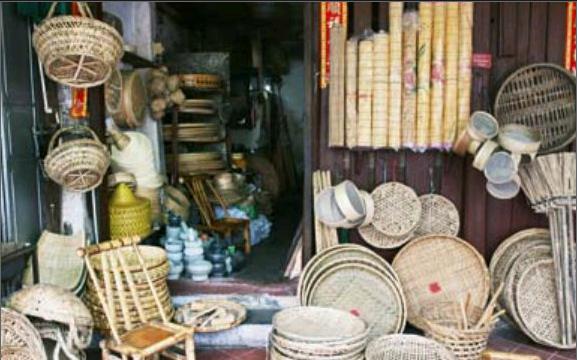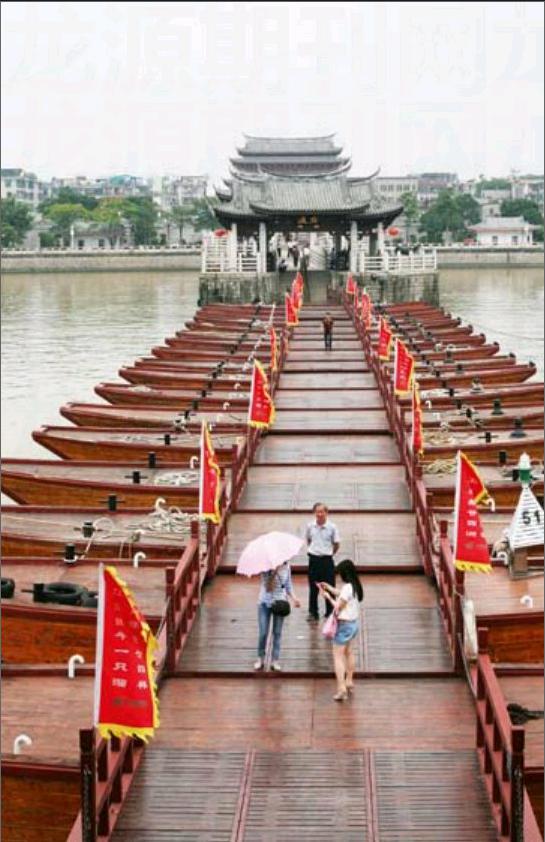A Day in Chaozhou
2015-06-16byCecileZehnacker
by+Cecile+Zehnacker


Chaozhou lies in eastern Guang- dong Province near the Fujian border, along the Hanjiang River. Tradition holds that it was founded over 1,700 years ago. The city is renowned not only in China but throughout the world for its rich culture and delicious cuisine, which has been spread to various Southeastern Asian countries and the West by Chaozhou emigrants.
A major landmark of Chaozhou is the Guangji Bridge, celebrated as one of Chinas four most famous ancient bridges along with Lugou, Zhaozhou, and Luoyang bridges. It is an extremely old, singular bridge that was first built during the Southern Song Dynasty (1127 – 1279). Originally, it was a floating bridge consisting of 86 boats connected to each other. It was destroyed in a major flood in 1174, and the government ordered it rebuilt. Then, builders placed solid stone piers on both sides of the river and construction continued over years and through dynasties. Todays bridge is higher than the original but remains the same. I was amazed by its design. The solid stone piers form long solid pontoons on both sides of the river, and the center is removable to allow ships to pass through. I was lucky enough to see it assembled one morning: Four sets of four boats tethered together lined up one after the other at the bridge, pulled by a tugboat. The process seemed precise, with each step perfectly orchestrated. The resulting creation appeared quite impressive: passage across the river across 16 linked up boats.
And Chaozhou has much more to offer. On one side of the bridge lies the city gate, “Guangjimen Chenglou.” Constructed during the Ming Dynasty (1368-1644), it is considered the most spectacular of seven ancient gates in the city. It is a three-story tower with beautiful architecture resembling a palace that offers a great view of Guangji Bridge as well as the city.
After passing this gate, a new scene appears: a commercial area with many small traditional shops. The streets are filled with people, scooters and tuktuks. The architecture is very specific to Southern China. In the old town of Chaozhou, the boisterous atmosphere and stunning architecture remind me of Penang, Malaysia, where, historically, many Chaozhou emigrants settled and brought building techniques along with delicious food. Chaozhou is famous for its cuisine, especially street food, as is Penang, whose favorites are descendants of Chaozhou cuisine. Chaozhou cuisine is largely seafood and vegetarian dishes and is recognized as being healthy as well as delicious. The specificity of the cuisine lies in the light seasoning that gives way to the freshness of the ingredients. The cooking methods are also unique, involving a lot of poaching, steaming and braising in addition to traditional stir-fry, which preserves the authentic taste of each ingredient.

Chaozhou cuisine is often served with a special tea: Gongfu tea or “kung fu” tea, which means “making tea with effort,” literally. Gongfu tea is traditionally served in a tea ceremony from Guangdong Province that employs specific methods and tools to achieve a perfect infusion of tea leaves. The leaves employed are strong oolong tea, which tastes slightly bitter, and the ceremony remains important social etiquette in Chaozhou.
Another major aspect of Chaozhou is its local dialect. Although Guangdong natives already use two languages, Cantonese and Mandarin, on a daily basis, people from Chaozhou actually also speak a third, local dialect called Chaozhou or Teochew language. It has preserved many old pro- nunciations and words that have been lost in other modern local dialects. It is considered by many linguists as one of the most conservative Chinese dialects. Its origins have been traced to between the 9th and 15th centuries, when a group from Fujian Province migrated to Chaozhou because of overpopulation. Due to the geographical distance, the language evolved differently, developing into a unique dialect. It is spoken by 10 million Chinese people in Chaoshan and 5 million living in other countries. The Chaoshan region around the cities of Chaozhou and Shantou is the origin of many Chinese people living abroad, some across many generations. Most of their ancestors left China between the 17th and 20th centuries to immigrate to regions in Southeast Asia and the West. This has made the Chaozhou language one of the widest spoken Chinese dialects in the world.